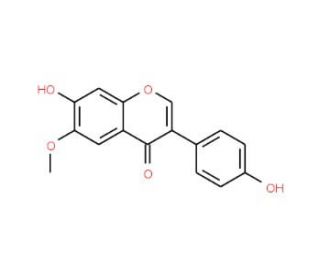

Glycitein (CAS 40957-83-3)
ACCÈS RAPIDE AUX LIENS
La glyciteine est une isoflavone O-méthylée que l'on trouve dans les produits alimentaires à base de soja et qui représente environ 5 à 10 % du total des isoflavones. La glyciteine appartient à la classe des composés organiques connus pour leur structure polycyclique et leur groupe cétone sur l'atome de carbone C4. Elle est pratiquement insoluble dans l'eau et est considérée comme une molécule relativement neutre. La glyciteine a été détectée dans des biofluides tels que l'urine et le sang, ce qui indique sa présence après consommation. Elle est principalement localisée dans la membrane cellulaire et participe à des réactions enzymatiques. La glyciteine peut être biosynthétisée à partir de l'isoflavone et convertie en glyciteine 4'-O-glucuronide. Ce phyto-œstrogène présente une faible activité œstrogénique en déplaçant la liaison de l'œstradiol au récepteur des œstrogènes. La glycitéine a démontré divers effets biologiques, tels que la suppression de la prolifération des ostéoblastes et la promotion de la différenciation. Elle a également montré un potentiel dans l'atténuation des changements vasculaires athérosclérotiques et la protection contre la toxicité induite par la bêta-amyloïde et le stress oxydatif. En dehors du corps humain, la glycitéine peut être trouvée dans les aliments à base de soja comme le yaourt au soja, le lait de soja, les graines de soja et d'autres produits à base de soja. Cela en fait un biomarqueur potentiel pour la consommation de ces produits alimentaires. La glyciteine est également identifiée comme une méthoxyisoflavone, dérivée du mycélium du champignon Cordyceps sinensis. Elle sert de métabolite végétal, de phytoestrogène et de métabolite fongique, ce qui contribue à la diversité de ses rôles et de ses origines dans différents contextes.
Glycitein (CAS 40957-83-3) Références
- Expression des gènes candidats de la flavonoïde 6-hydroxylase dans des génotypes de soja normaux et mutants pour la teneur en glycitéine. | Artigot, MP., et al. 2013. Mol Biol Rep. 40: 4361-9. PMID: 23695494
- Transformation microbienne de composés bioactifs et production d'ortho-dihydroxyisoflavones et de glycitéine à partir de pâte de soja fermentée naturelle. | Roh, C. 2014. Biomolecules. 4: 1093-101. PMID: 25513748
- Traitement du lait de soja avec une teneur plus élevée en aglycones d'isoflavones. | Baú, TR. and Ida, EI. 2015. Food Chem. 183: 161-8. PMID: 25863624
- Évaluation des isoflavonoïdes de soja contre l'herpès. | Argenta, DF., et al. 2015. Arch Virol. 160: 2335-42. PMID: 26156104
- La glyciteine induit une apoptose dépendante des espèces réactives de l'oxygène et un arrêt du cycle cellulaire G0/G1 par la voie MAPK/STAT3/NF-κB dans les cellules cancéreuses gastriques humaines. | Zang, YQ., et al. 2019. Drug Dev Res. 80: 573-584. PMID: 30916421
- Bioréacteur à membrane pour l'étude de la neurodégénérescence. | Morelli, S., et al. 2019. Mater Sci Eng C Mater Biol Appl. 103: 109793. PMID: 31349430
- Activité antigrippale des composants du thé Adlay. | Nagai, E., et al. 2019. Plant Foods Hum Nutr. 74: 538-543. PMID: 31728799
- La consommation d'isoflavones alimentaires est inversement associée à la stéatose hépatique non alcoolique, à l'hyperlipidémie et à l'hypertension. | Wang, X., et al. 2022. Int J Food Sci Nutr. 73: 60-70. PMID: 33899670
- Étude des interactions entre MeOH et Daidzein au niveau moléculaire. | Zhao, H., et al. 2021. ACS Omega. 6: 21491-21498. PMID: 34471752
- La glyciteine exerce des effets neuroprotecteurs sur le stress oxydatif et la mort cellulaire apoptotique déclenchés par la roténone dans le modèle cellulaire de la maladie de Parkinson. | Dong, N. and Yang, Z. 2022. Acta Biochim Pol. 69: 447-452. PMID: 35691030
- Constituants chimiques des fleurs de Pueraria lobata et leurs propriétés cytotoxiques. | Kim, Y., et al. 2022. Plants (Basel). 11: PMID: 35807603
- Mécanisme de la glycitéine dans le traitement du cancer du côlon basé sur la pharmacologie de réseau et l'ancrage moléculaire. | Xiang, T. and Jin, W. 2022. Lifestyle Genom.. PMID: 36183698
- Profilage complet des métabolites de quatre haricots différents fermentés par Aspergillus oryzae. | Lee, YH., et al. 2022. Molecules. 27: PMID: 36432017
- Comprendre l'activité hypocholestérolémique des isoflavones de soja: Compléter le puzzle par des simulations informatiques. | Hermanto, FE., et al. 2022. J Biomol Struct Dyn. 1-7. PMID: 36443895
Informations pour la commande
| Nom du produit | Ref. Catalogue | COND. | Prix HT | QTÉ | Favoris | |
Glycitein, 5 mg | sc-203419 | 5 mg | $90.00 | |||
Glycitein, 25 mg | sc-203419A | 25 mg | $390.00 |
